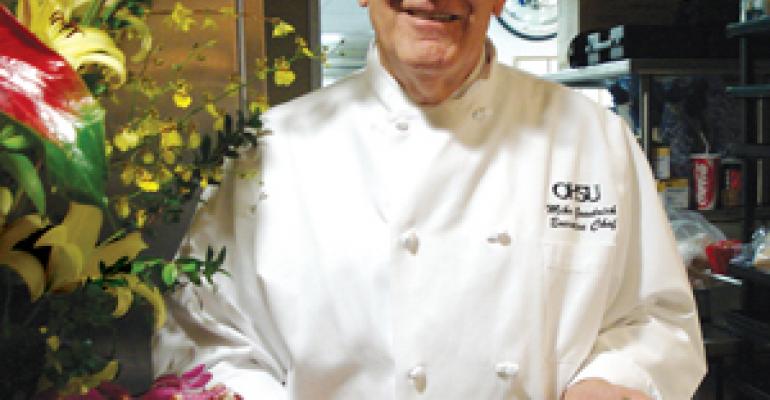Hospital chefs and nutrition specialists nationwide say the dosage of healthful fare they are offering patrons is on the rise as patients, employees and visitors take wellness to heart.
According to a recent study by the National Society for Healthcare Foodservice, 88 percent of health care foodservice professionals said they have seen notable growth in the number of requests for healthy meal options from all customers.
“It’s been a growing trend,” said Mike Goodrich, executive chef at Oregon Health & Science University Hospital in Portland, Ore. He added, “Consumers are a lot more knowledgeable about food than they were in the past, and it is our responsibility to respond to their requests for healthier options and provide them with things that are healthy for them and taste good.”
In response, Oregon Health, whose foodservice is composed of seven self-operated grab-and-go outlets and three full-service cafeterias, has increased its vegetarian and organic offerings. Oregon Health serves approximately 7,500 meals a day and provides food for 450 patients. Although the average check is between $4 and $5, Goodrich said customers are willing to pay extra for some items.
“We’ve added a number of vegan and grilled vegetarian wraps,” he said. “And on any typical Monday [when we serve them], we’ll sell around 250. Customers are willing to pay more if the quality is there.”
After receiving several requests for sushi, the hospital six months ago hired a sushi chef and is seeking a second one, he said. Sushi now is offered daily in the main cafe and at some of the grab-and-go outlets.
Goodrich said the hospital offers no fast-food options and there has been a move away from many deep-fried foods, including fish and chips, chicken strips, and French fries.
“We can go back 20 years to trace the beginning of the fad to reduce fat, but we’ve turned a corner; that fad is now a trend in 2007,” said John Riegler, director of foodservice for Milwaukee-based Aurora Healthcare Systems.
Riegler noted that requests for seafood and sushi have reached all-time highs at his facilities. “We have a local provider, and we’re selling around 100 orders a day,” he said. “Our average [cafeteria] guest check is $3.50, and the lowest priced sushi item is $4.50 and they go up to $9. People don’t care how much it costs; they just want to have it.”
Riegler said Aurora’s annual cash sales top $3.4 million and systemwide sales are around $5.3 million. He added that 80 percent of the volume is employee-based. Aurora’s foodservice operations consist of an employee cafeteria, two corporate cafes, a coffee kiosk and patient feeding for more than 500 beds. He noted that fresh, made-to-order deli sandwiches also sell well. Meanwhile, there has been a decline in the demand for deep-fried fare.
“We used to serve country-fried steak, and every time it was on the line we’d sell 600 of them,” he said. “Now, if we sell 200 we’re good. That’s a 66-percent drop in that item alone.”
At Brookhaven Memorial Hospital in Brookhaven, N.Y., director of foodservice Arthur Bretton said sales of healthful breakfast items have more than doubled in the three years he has worked there. The hospital feeds some 2,500 employees.
“When I first started, sales averaged around $17,000 a month,” he said. “Now it’s up to around $48,500. I attribute this to giving more choice and making those choices convenient, enticing, healthy and appealing.
“People realize that even though they eat so many meals away from home, they can’t really splurge all the time. They know they can’t buy unhealthy food all the time, especially in a hospital setting where they see people every day who have had heart attacks.”




